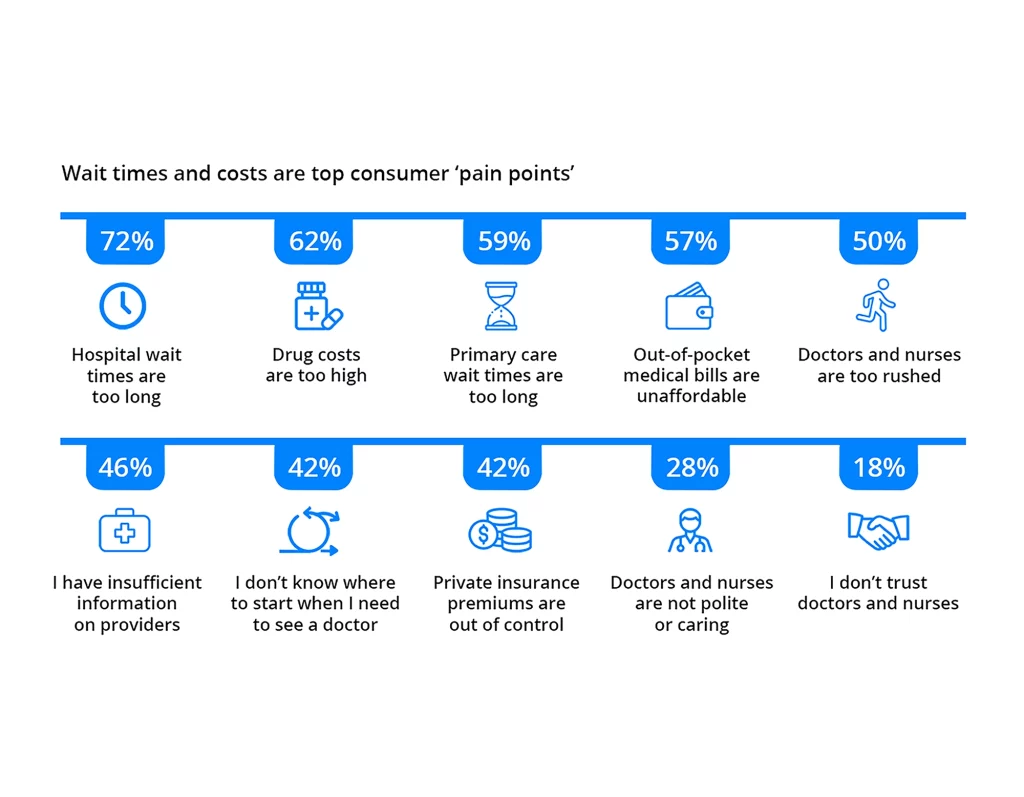Is Access To Healthcare Painful – Active Wellness Has Answers
When a consumer looks at access to healthcare for personal, family and friends what comes to his mind are harrowing experiences, challenges, fear, apprehension generating anxiety.
Fears of a Consumer on Healthcare
- What is this problem and what should I do?
- Which doctor should I go to?
- Why did this happen to me or my family?
- Why no one guided me on how to prevent it?
- How much with the treatment cost?
- I fear that I will be overcharged?
- What challenges will I face while accessing healthcare services?
- How many days of earning livelihood will get lost?
- How will I pay the bills for my sickness? …. And so on

Among all of the pain points wait time for consulting doctors, tests, radiological activities, and also the generation of reports acquire the highest wait time around 72%.
Next is the cost of the medications. Rising medications costs affects a large segment of consumers and a major pain point that covers 62%. Let us revisit the pain points
Consumer Pain Points Revisited
Let’s have a deep look at what are the pain points that consumers are facing and how we can help alleviate them. Some are addressable while others are systemic in nature over which the consumer or doctor has no control. These challenges vary depending on factors like location, geography, healthcare system design, socioeconomic status, and personal health conditions.
The Active Wellness Health Ecosystem addresses precisely these issues to reduce the pain and increase satisfaction. It provides a connected collaborative personalized health ecosystem that looks out and determines risk & helps reverse it; monitors and tracks all the problems related to health and sickness; it improves the quality as well as the accessibility while enhancing patient outcomes. It manages patients in the community settings and offers hybrid care.
Active Wellness Solutions cover the complete range of health needs starting with E-medications (ActiveMED) that cover converting prescriptions to drug orders, intake drug alerts, tracks compliance; checks for drug interactions to prevent medication errors which account for 14% of medical hospital costs. Its integrated nature ties all the services a patient needs such as ActiveLAB (E-Tests), ActiveCONSULT (Hybrid Consults), E-Communications, Provider portal (ActiveMD) and personal health record management, care team communicator and more. This integrated AI driven risk scoring and proactive interventions coupled with clinical screenings and immunizations is the first of its type revolutionary product. It post discharge care hybrid model is unique in the healthcare industry. Click me to see the snapshot of services.
Click Here To Visit Active Wellness
What Millennials Expect From Providers
1. Convenience and Efficiency
Millennials prioritize convenience and efficiency. They expect services to be easily accessible, whether it’s through online platforms, mobile apps, or streamlined customer service processes. They appreciate services that save them time, effort & money.
2. Transparency and Authenticity
Millennials tend to appreciate healthcare services that are transparent about their practices, values, and social responsibilities. They often research a company’s background and ethics before making a purchase or commitment.
3. Value for Money
While Millennials might be willing to spend on quality products and services, they are also conscious of their finances due to the economic challenges many have faced. They expect providers to offer reasonable pricing and good value for the cost.
4. Flexibility and Work-Life Balance
Millennials often value flexibility in their own lives, and they may appreciate service providers that offer flexible options that fit their schedules and lifestyles.
What Gen Z Expects From Provider
1. Technology and Convenience
Having grown up with smartphones and the internet, Gen Z expects services to be easily accessible through digital platforms. They value convenience, quick response times, and seamless digital experiences.
2. Instant Communication
Gen Z is used to real-time communication through messaging apps and social media. They expect prompt and efficient customer service, often preferring text-based communication over traditional phone calls.
3. Entertainment and Engagement
Gen Z enjoys interactive and engaging experiences. They are drawn to brands and services that offer entertainment alongside functionality.
4. Innovation
Gen Z is attracted to innovative and cutting-edge products and services. They value forward-thinking companies that are willing to experiment with new technologies and ideas.
5. Personalization
Gen Z values personalized experiences. They expect service providers to offer tailored solutions and recommendations based on their preferences and behaviors. This includes personalized marketing messages, product suggestions, and user interfaces.
Why is OPD Care a nightmare?
A story narrated by a friend:
A few days ago, I accompanied my elderly aunt for her regular follow-up to a hospital. Entering the hospital, the long serpentine queue to the registration desk was overwhelming.
The never-ending queue snaked through the hospital corridors which we also joined. The wait turned from minutes turned to hours, our patience started to wear thin.
The atmosphere in the line was tense, with people growing increasingly frustrated and restless.
Long standing took a toll her, because of her arthritis. She struggled to maintain her balance and her discomfort was evident. Despite pain, she was determined to complete the necessary paperwork and receive the care she needed.
The registration desk had few staff & appeared overwhelmed. Despite doing their best to manage the influx of patients, the sheer volume of people seemed to exceed their capacity.
After registration the journey of joining the queue outside the doctor’s office started which lasted for about one hour. At the end it took us three hours to be seen for 5 minutes in the follow up.
This exposes how the processes are not designed for the high volume and even those which could be managed through E-Consult were in the queue.
FRIENDS HIGHEST REGRET:
Why I did not heed my friend’s advice to follow & join Active Wellness proactive connected care platform that offers a wide range of services. A hybrid care model that offers clinic & virtual OPD visits and other functionalities for me and my complete family would have given me peace of mind & convenience of care.
To Sum up all the challenges and frustrations of consumers and providers can be solved through this efficient virtual hospital that offers a DOC-IN-A-BOX solution that starts with self-help and when necessitated advises physician visits both clinic and virtual. Active Wellness integrated patient centric care platform meets this out of Hospital (outpatient, chronic care & home care) need.
Global Pain Points To Access Healthcare Services
1. Lack of Access and Availability
Many individuals, especially in rural or remote areas, struggle to access healthcare facilities due to the absence of nearby medical facilities, transportation issues, or inadequate healthcare infrastructure.
2. High Costs and Affordability
Healthcare expenses, including insurance premiums, copays, deductibles, and out-of-pocket costs, can be a significant burden for patients, especially those without comprehensive insurance coverage.
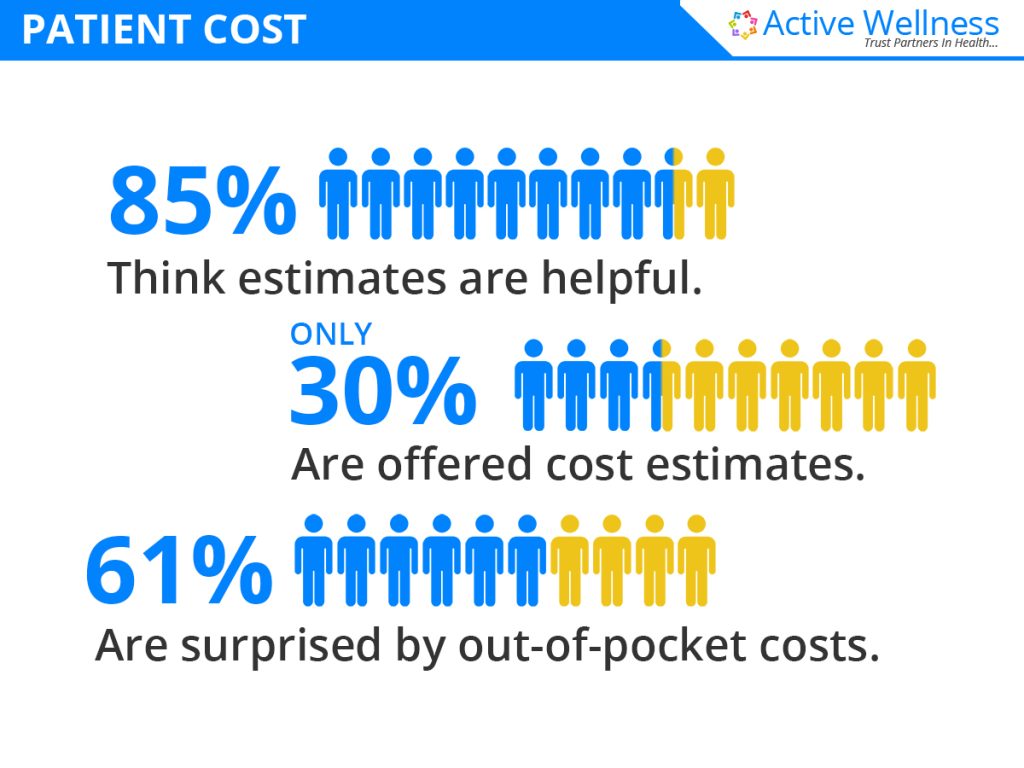
3. Complex Insurance Processes
Navigating health insurance can be confusing and time-consuming, leading to frustration and misunderstandings about coverage, claims, and approvals.
4. Communication Challenges
Inadequate communication between healthcare providers and patients, as well as unclear explanations of diagnoses and treatment options, can lead to confusion and anxiety. Effective communication between patients and healthcare providers is crucial. Language barriers, limited health literacy, and cultural differences can hinder proper understanding of diagnoses, treatment plans, and medication instructions
5. Limited Specialist Access
Accessing specialized care often involves referrals and waiting lists, which can lead to delayed diagnosis and treatment, particularly for conditions requiring specialized expertise.
Pain Points Faced at Provider Offices / Clinics
Patients often encounter several pain points when receiving outpatient care. These pain points can vary based on the healthcare system, location, and specific circumstances, but some common issues are as follows
1. Long Wait Times
Outpatients clinics can sometimes have long wait times, causing frustration and inconvenience for patients who may already be dealing with discomfort or illness.
2. Appointment Scheduling
Difficulty in securing timely appointments, especially with specialists, can lead to delays in treatment and prolonged discomfort.
3. Registering And Consulting
Hospitals have a lengthy registration process because they collect a large amount of data. New patients must fill out and sign a slew of paperwork. They provide insurance and identification information, which delays their appointment with the doctor.
4. Limited Consultation Time
Short consultation times can leave patients feeling rushed and prevent them from discussing all of their concerns and questions with the healthcare provider.
5. Transportation and Accessibility
Lack of reliable transportation or accessibility issues can make it challenging for some patients to reach outpatient facilities, especially for those with mobility issues.
6. Follow-up and Monitoring
Inadequate follow-up care and monitoring after initial appointments can lead to unresolved health issues and potentially more serious complications.
7. Limited Preventive Care
Outpatient care often focuses on treating existing conditions rather than preventive care, which can lead to missed opportunities for early intervention and disease prevention. Preventive services like vaccinations, screenings, and health education might not be readily available in some community settings, leading to missed opportunities for early detection and disease prevention.
8. Lack Of Continuity of Care
Frequent changes in healthcare providers within outpatient settings can disrupt the continuity of care and patient-provider relationships. patients might see different healthcare providers for various issues, which can lead to fragmented care. Lack of coordination and communication between providers can result in gaps in the patient’s overall treatment plan.
9. Delay in Diagnostics and Reports
This leads to a delay in the treatments and then ultimately if there is a delay in diagnostics tests which results in delayed reports which in turn affects the patient’s overall health and may also create a state of anxiety for patient.
10. Lack of Technology Integration
Healthcare institutions are lagging in adoption of technology because the solutions being offered are Technology solutions that are not domain driven. Existing solutions are working in SILOs making it harder to share medical information and provide connected distributed care.
Improving communication, streamlining processes, enhancing patient education, and leveraging technology can all contribute to a more patient-centered outpatient care experience. The answer lies in a cloud based virtual hospital.
11. Provider Shortages
Shortages of healthcare providers, including doctors, nurses, and other healthcare professionals, can result in overworked staff and difficulty in accessing timely care.
Pain Points Faced by Patients in Hospital Care

Patients can experience various pain points or challenges while receiving hospital care. Beyond the pain points mentioned above the consumers are troubled by:
1. Lack of Personalized Care
Some patients may feel that their care is not tailored to their individual needs, which can impact their overall experience and treatment outcomes.
2. Poor Coordination and Disorganization
Poor coordination among healthcare teams can result in inefficiencies, errors in treatment, and confusion for patients.
3. Medication Errors
Medication administration, dosage, or timing mistakes can pose serious risks to patient’s health and well-being.
4. Inadequate Emotional Support
Patients often need emotional support in addition to medical care, and the absence of this can negatively affect their well-being.
5. Discharge Planning and Follow-up
Insufficient preparation for discharge, unclear instructions, and a lack of follow-up can lead to complications after leaving the hospital.
6. Financial Concerns
High medical costs, unexpected bills, and insurance-related issues can cause stress for patients and their families.
7. Limited Control
Hospitalized patients may feel a loss of control over their routines, decisions, and environment, which can impact their emotional state.
8. Risk of Healthcare-Associated Infections
Hospital-acquired infections can occur due to inadequate hygiene practices, posing risks to patient safety.
9. Disruption of Daily Life
Hospitalization can disrupt patients’ work, family responsibilities, and daily routines, causing stress and inconvenience.
10. Physical Discomfort
Uncomfortable beds, medical procedures, and physical exams can cause discomfort and pain for patients.
11. Unclear Visitation Policies
Restrictions on visitation can lead to feelings of isolation and loneliness, particularly for long-term patients.
COMMUNITY CARE THE NEW NORMAL
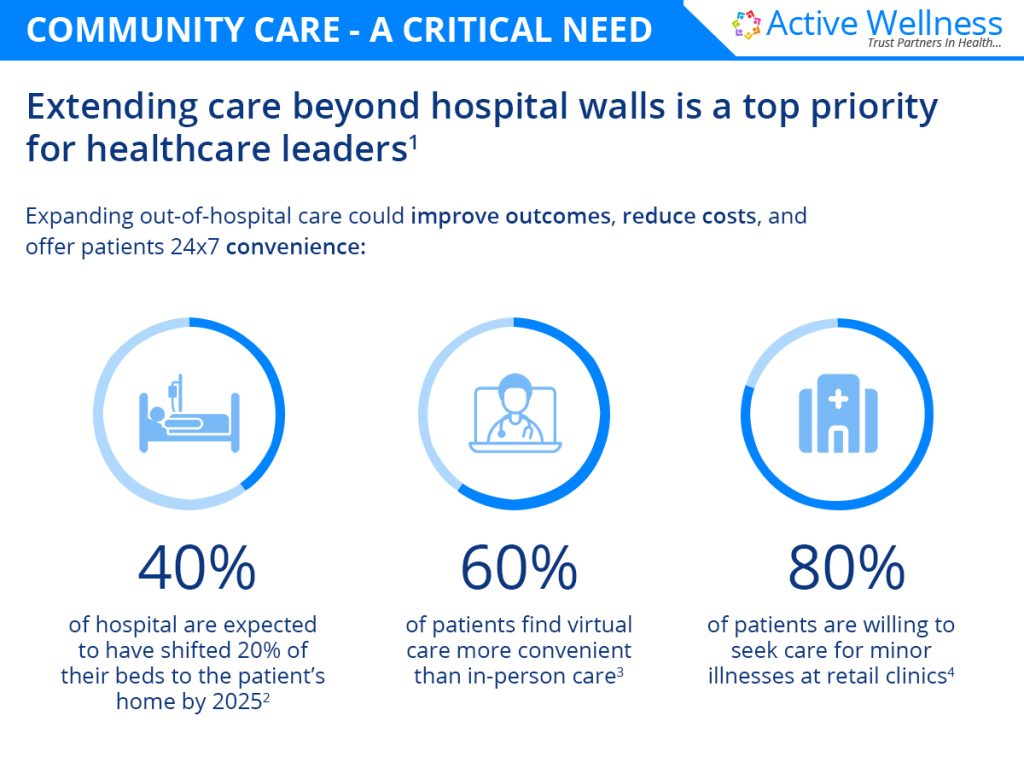
With the increasing focus on costs and managing the patient at home is now being accepted as a natural new normal
General Pain Points Faced by Different Age People
Pain Points Faced By Parents Of Children
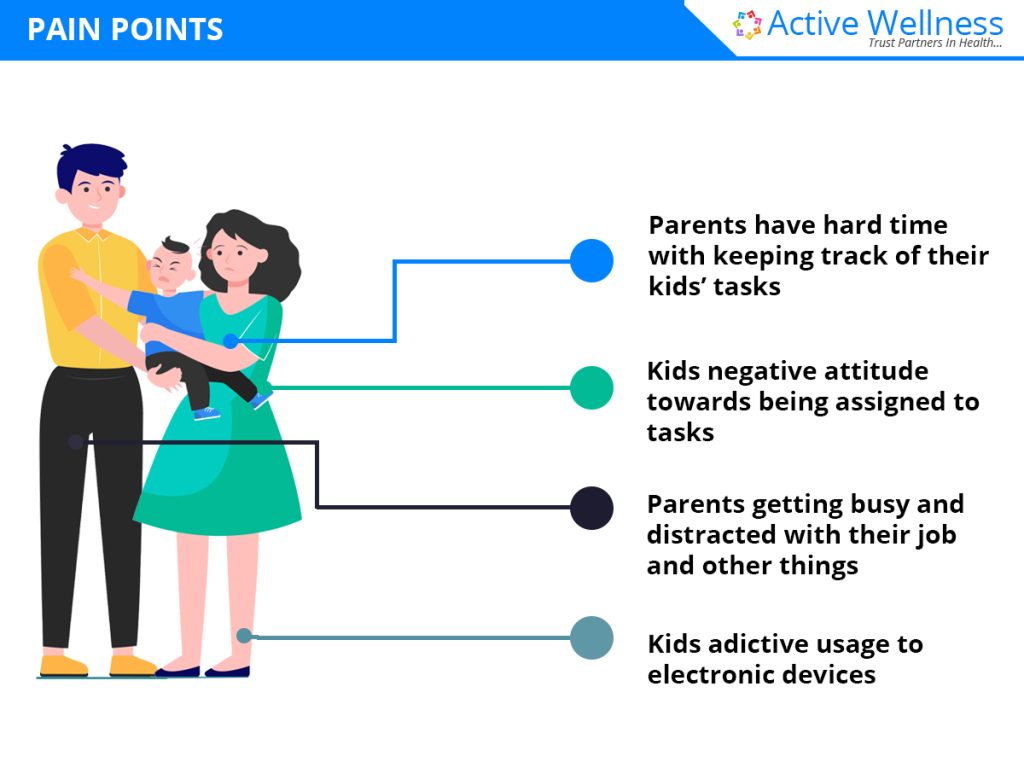
All of the above pain points can be solved by Active Wellness Solutions as they have a complete program that is specially designed according to the children’s needs and named a child care program, where new parents can get help for all their problems.
Pain Points Faced by Women
- Women’s privacy and dignity can be jeopardized in hospital settings. They may face difficulties due to lack of female healthcare providers, or insufficient personal hygiene facilities.
- Pregnant women suffer a lot because they have to wait for the doctor for long hours, there are delays in the scans and the generation of reports, and it is now very common for a simple checkup to take up the entire day.
- Active Wellness has specific women’s health programs where women and as well as girl child health issues detect diseases in advance and manage them with their personalized medication plans.
Pain Points Faced by Elderly People
Elderly people face a lot of problems in the healthcare system, and challenges faced by them and their percentage is given below
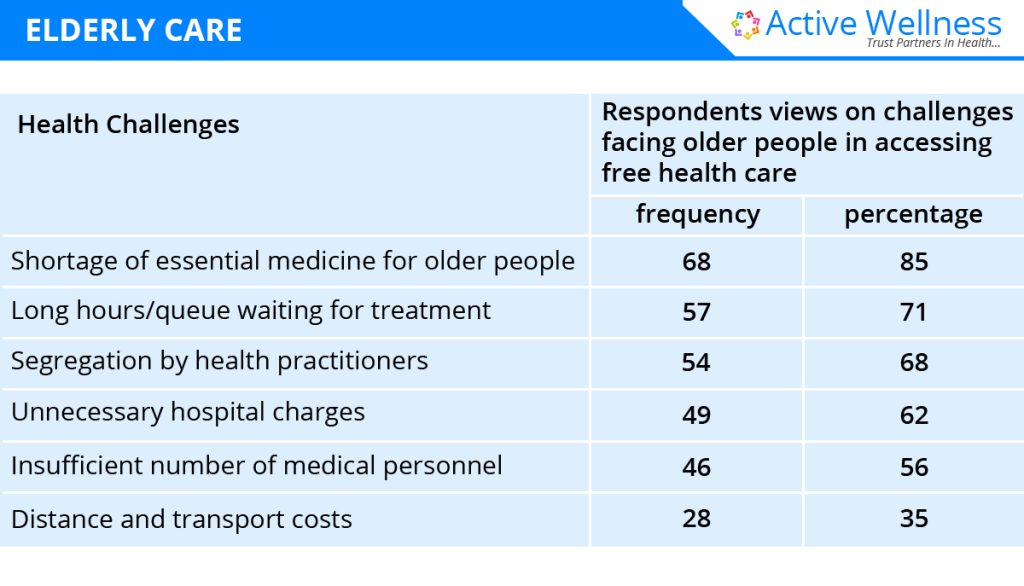
Active Wellness Solutions again has come up with a specific plan for elderly people named elderly care that manages, tracks, and monitors all the problems and take care of their health.
The illustration above explains in detail how Active Wellness Solutions assists the elderly with their elderly care plan.
HOSPITAL TO HOME TRANSITION
Hospitals and healthcare systems are increasingly recognizing the importance of improved transition planning to enhance patient’s experiences and outcomes after leaving the hospital.
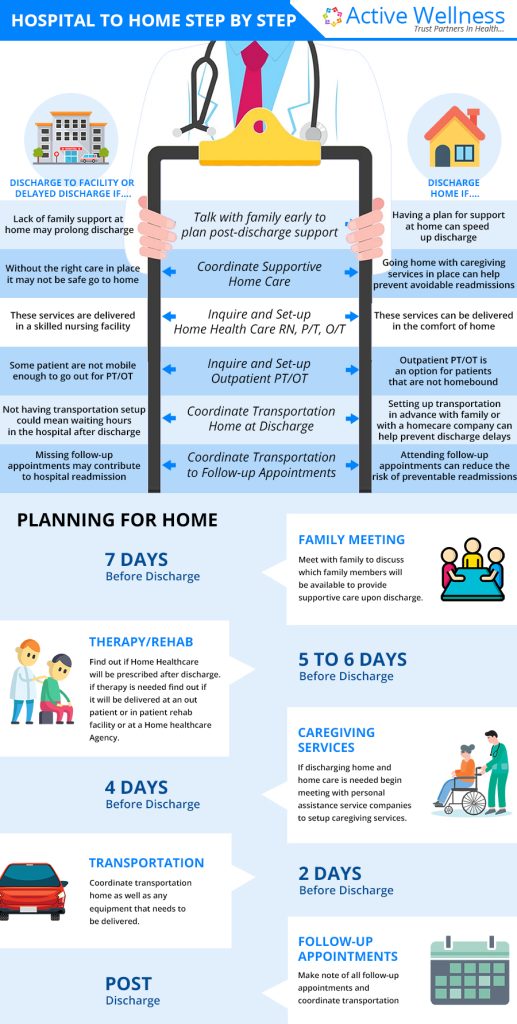
Patients often face several pain points when it comes to post-discharge care, which refers to the period after they leave the hospital or healthcare facility. These challenges can impact their recovery and overall well-being. Some common pain points include
1. Lack of Clear Instructions
Patients may receive vague or unclear instructions about medications, follow-up appointments, dietary restrictions, and activity limitations. This can lead to confusion and potential non-compliance.
2. Limited Access to Healthcare Professionals
Patients might feel isolated after discharge and have limited access to healthcare professionals for questions or concerns, which can be particularly challenging if complications arise.
3. Coordination of Care
Coordinating follow-up appointments, diagnostic tests, and specialist visits can be difficult, especially if multiple healthcare providers are involved. This can lead to gaps in care and delays in necessary treatments.
4. Transportation and Mobility
Some patients might have difficulty arranging transportation to follow-up appointments or picking up prescriptions, especially if they are still recovering or lack support.
5. Language and Health Literacy Barriers
Patients with limited health literacy or those who speak a different language might struggle to understand and follow post-discharge instructions.
6. Managing Chronic Conditions
Patients with chronic conditions need ongoing management after discharge, and they might struggle with incorporating new routines into their daily lives.
Above mentioned pain points require a comprehensive approach that involves effective communication, education, support systems, and the integration of technology to facilitate better post-discharge care.
Future With Active Wellness Care Ecosystem
Having understood the pain points faced by the consumer in different age groups here’s what we should do.
Active Wellness is an AI engine that has been designed to help alleviate these pain points and become your TRUST PARTNER IN HEALTH. It is an all-in-one solution to access to care that engages, enable and empowers users and provides 360-degree solution to problems.
- It helps reduce all the pain points listed above.
- Offer a personalized ecosystem for the patient and delivers smart and healthy living
- The wait time can be drastically reduced / completely eliminated by using active wellness solutions hybrid care model that enables clinic and E-Visits.
- Schedule your appointment at home, with power to reschedule and cancel if needed.
- Opens a 24×7 communication line between you and your care teams to take up follow up connections and queries
- Reduces your travel time to the clinic.
- Tests samples are collected from home, and E- reports in your mail and your medical records.
- Engagement and communication are super easy and complete personal health records of patients are managed in order to reverse the risks if any and provide them with a personalized health care system.
- Home care services are provided with the hybrid model reports provided within 24 hours and a virtual assistant is always available to solve the queries if any which in turn leads to a healthy and productive consumer.
Reference
- https://www.pcisgold.com/blog/conquering-frustration-4-patient-pain-points-and-how-to-fix-them
- https://www.hpnonline.com/patient-satisfaction/article/21114283/new-survey-reveals-top-pain-points-for-healthcare-consumers
- https://www.pcisgold.com/blog/conquering-frustration-4-patient-pain-points-and-how-to-fix-them
- https://www.caringseniorservice.com/blog/infographic-hospital-to-home-step-by-step-guide
- https://activewellness.in/Active/homecare/elderly-home-care.aspx
- https://activewellness.in/Active/homecare/home-health-services.aspx
- https://activewellness.in/econsult/provider-consult-home.aspx
- https://activewellness.in

